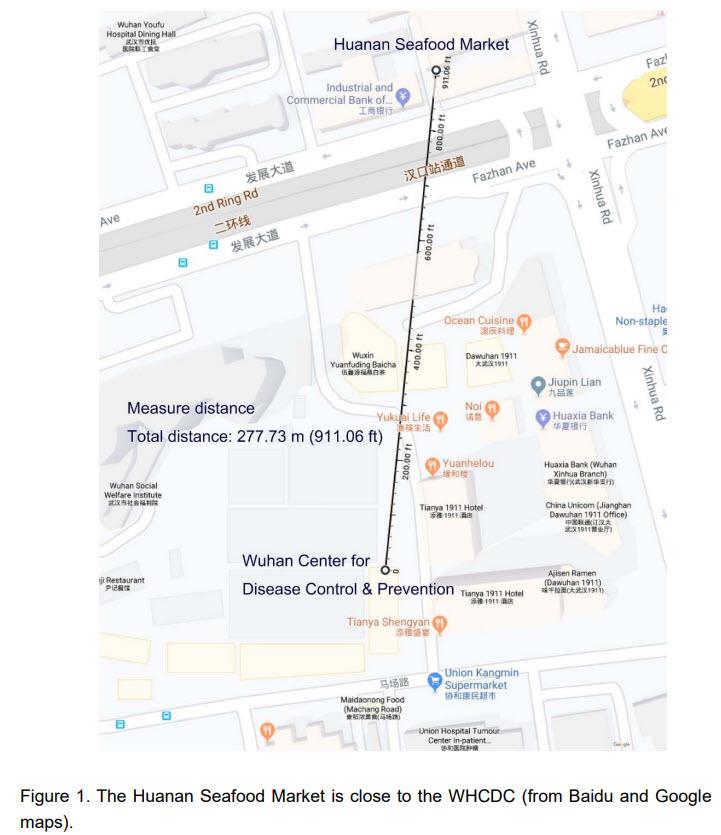The uncertainty and the debate over the origins of the coronavirus pandemic are growing with each passing day.
One week after the White House asked scientists to finally investigate whether the Covid-19 virus was bio-engineered (i.e., created in a lab), none other than CNBC jumped on the bandwagon and echoing a similar question by Senator Tom Cotton - and of course, Zero Hedge - said "maybe the coronavirus was man made."
All this is taking place as the mainstream media, whose purpose is similar to that of Beijing in minimizing public concerns and panic even if it means fabricating reality, presses on with the popular theory that the virus emerged from the Huanan seafood market in Wuhan (we recently showed why this appears very unlikely) while branding anyone who suggests that the coronavirus might have originated as a bioweapon developed in a secretive Wuhan lab as deranged conspiracy theorist (a propaganda approach first popularized in the 1960s by the CIA to discredit controversial views).
Indeed, just today, the FT reported that Trevor Bedford, of the Fred Hutchinson Cancer Research Center in Seattle, "rubbished stories circulating on social media that Covid-19 was created at Wuhan Institute of Virology or elsewhere in China." Bedford is of course entitled to his opinion, which was only reinforced by the lack of any dissenting views from the scientific community, especially in "ground zero", China.
That has now changed, however, with what may be a "smoking gun" report, first noted by Harvard to the big house, from a scientist at the prestigious South China University of Technology in Guangzhou China. A pre-print published by Botao Xiao and Lei Xiao, titled "The possible origins of 2019-nCoV coronavirus" whose abstract is the following...
The 2019-nCoV has caused an epidemic of 28,060 laboratory-confirmed infections in human including 564 deaths in China by February 6, 2020. Two descriptions of the virus published on Nature this week indicated that the genome sequences from patients were almost identical to the Bat CoV ZC45 coronavirus. It was critical to study where the pathogen came from and how it passed onto human. An article published on The Lancet reported that 27 of 41 infected patients were found to have contact with the Huanan Seafood Market in Wuhan. We noted two laboratories conducting research on bat coronavirus in Wuhan, one of which was only 280 meters from the seafood market. We briefly examined the histories of the laboratories and proposed that the coronavirus probably originated from a laboratory. Our proposal provided an alternative origin of the coronavirus in addition to natural recombination and intermediate host.
... and an especially ominous conclusion:
In summary, somebody was entangled with the evolution of 2019-nCoV coronavirus. In addition to origins of natural recombination and intermediate host, the killer coronavirus probably originated from a laboratory in Wuhan.
Who is Botao and should anyone listen to him? Well, yes: this is what we find about the research group of the Harvard post-doc:
The Xiao group study mainly in the fields of cellular and molecular biomechanics, single molecule biophysics and engineering. Current research areas are: protein-ligand interactions, DNA and RNA assembly, high-throughput nanometer measurements and manipulation, mathematical modeling and quantitative analysis. The experimental techniques include: magnetic tweezers, optical tweezers, biomembrane force probe, fluorescent microscopy, genetic engineering, and chromatography. An project example is using high-throughput single molecule techniques to study the modulation of protein drugs on interactions of integrins and their ligands such as TGF-beta. We also study von Willebrand Factor and glycoproteins on platelets. We collaborate with a number of well-known universities and institutions, and a few enterprises. Our research will be of relevance for the prevention and treatment of cancer, immune and cardiovascular diseases.
But what is far more interesting, and important, is that the paper was supported by China's National Natural Science Foundation, which means that the paper would likely never see the light of day if someone in Beijing did not stand to gain politically by endorsing the contrarian theory that a Wuhan biolab was indeed the source of the infection.
Which begs the question: is China's political elite set to change the narrative it has been spinning since day one about the origins of the coronavirus, and in order to appease an increasingly angry population, points the finger to one or more scientists at the Wuhan Center for Disease Control and Prevention and/or Wuhan Institute of Virology. Perhaps even the same scientists we highlighted two weeks ago, and which led to our twitter ban?
And until we eagerly await the answer, here is the gist of Botao's paper, which we repost here just in case it does disappear after all (ResearchGate link here):
The possible origins of 2019-nCoV coronavirus
Botao Xiao1,2* and Lei Xiao3
1 Joint International Research Laboratory of Synthetic Biology and Medicine, School of Biology and Biological Engineering, South China University of Technology, Guangzhou 510006, China
2 School of Physics, Huazhong University of Science and Technology, Wuhan 430074, China
3 Tian You Hospital, Wuhan University of Science and Technology, Wuhan 430064, China
Corresponding author: xiaob@scut.edu.cn
Tel / Fax: 86-20-3938-0631
The 2019-nCoV coronavirus has caused an epidemic of 28,060 laboratory-confirmed infections in human including 564 deaths in China by February 6, 2020. Two descriptions of the virus published on Nature this week indicated that the genome sequences from patients were 96% or 89% identical to the Bat CoV ZC45 coronavirus originally found in Rhinolophus affinis 1,2. It was critical to study where the pathogen came from and how it passed onto human.
An article published on The Lancet reported that 41 people in Wuhan were found to have the acute respiratory syndrome and 27 of them had contact with Huanan Seafood Market 3. The 2019-nCoV was found in 33 out of 585 samples collected in the market after the outbreak. The market was suspected to be the origin of the epidemic, and was shut down according to the rule of quarantine the source during an epidemic.
The bats carrying CoV ZC45 were originally found in Yunnan or Zhejiang province, both of which were more than 900 kilometers away from the seafood market. Bats were normally found to live in caves and trees. But the seafood market is in a densely-populated district of Wuhan, a metropolitan of ~15 million people. The probability was very low for the bats to fly to the market. According to municipal reports and the testimonies of 31 residents and 28 visitors, the bat was never a food source in the city, and no bat was traded in the market. There was possible natural recombination or intermediate host of the coronavirus, yet little proof has been reported.
Was there any other possible pathway? We screened the area around the seafood market and identified two laboratories conducting research on bat coronavirus. Within ~280 meters from the market, there was the Wuhan Center for Disease Control & Prevention (WHCDC) (Figure 1, from Baidu and Google maps).
WHCDC hosted animals in laboratories for research purpose, one of which was specialized in pathogens collection and identification 4- 6. In one of their studies, 155 bats including Rhinolophus affinis were captured in Hubei province, and other 450 bats were captured in Zhejiang province 4. The expert in collection was noted in the Author Contributions (JHT). Moreover, he was broadcasted for collecting viruses on nation-wide newspapers and websites in 2017 and 2019 7,8. He described that he was once attacked by bats and the blood of a bat shot on his skin. He knew the extreme danger of the infection so he quarantined himself for 14 days 7. In another accident, he quarantined himself again because bats peed on him. He was once thrilled for capturing a bat carrying a live tick8.
Surgery was performed on the caged animals and the tissue samples were collected for DNA and RNA extraction and sequencing 4, 5. The tissue samples and contaminated trashes were source of pathogens. They were only ~280 meters from the seafood market. The WHCDC was also adjacent to the Union Hospital (Figure 1, bottom) where the first group of doctors were infected during this epidemic. It is plausible that the virus leaked around and some of them contaminated the initial patients in this epidemic, though solid proofs are needed in future study.
The second laboratory was ~12 kilometers from the seafood market and belonged to Wuhan Institute of Virology, Chinese Academy of Sciences 1, 9, 10. This laboratory reported that the Chinese horseshoe bats were natural reservoirs for the severe acute respiratory syndrome coronavirus (SARS-CoV) which caused the 2002-3 pandemic 9. The principle investigator participated in a project which generated a chimeric virus using the SARS-CoV reverse genetics system, and reported the potential for human emergence 10. A direct speculation was that SARS-CoV or its derivative might leak from the laboratory.
In summary, somebody was entangled with the evolution of 2019-nCoV coronavirus. In addition to origins of natural recombination and intermediate host, the killer coronavirus probably originated from a laboratory in Wuhan. Safety level may need to be reinforced in high risk biohazardous laboratories. Regulations may be taken to relocate these laboratories far away from city center and other densely populated places.
Acknowledgements
This work is supported by the National Natural Science Foundation of China (11772133, 11372116).
Declaration of interests
All authors declare no competing interests.
References
1. Zhou P, Yang X-L, Wang X-G, et al. A pneumonia outbreak associated with a new coronavirus of probable bat origin. Nature 2020. https://doi.org/10.1038/s41586-020-2012-7.
2. Wu F, Zhao S, Yu B, et al. A new coronavirus associated with human respiratory disease in China. Nature 2020. https://doi.org/10.1038/s41586-020-2008-3.
3. Huang C, Wang Y, Li X, et al. Clinical features of patients infected with 2019 novel coronavirus in Wuhan, China. The Lancet 2019. https://doi.org/10.1016/S0140- 6736(20)30183-5.
4. Guo WP, Lin XD, Wang W, et al. Phylogeny and origins of hantaviruses harbored by bats, insectivores, and rodents. PLoS pathogens 2013; 9(2): e1003159.
5. Lu M, Tian JH, Yu B, Guo WP, Holmes EC, Zhang YZ. Extensive diversity of rickettsiales bacteria in ticks from Wuhan, China. Ticks and tick-borne diseases 2017; 8(4): 574-80.
6. Shi M, Lin XD, Chen X, et al. The evolutionary history of vertebrate RNA viruses. Nature 2018; 556(7700): 197-202.
7. Tao P. Expert in Wuhan collected ten thousands animals: capture bats in mountain at night. Changjiang Times 2017.
8. Li QX, Zhanyao. Playing with elephant dung, fishing for sea bottom mud: the work that will change China's future. thepaper 2019.
9. Ge XY, Li JL, Yang XL, et al. Isolation and characterization of a bat SARS-like coronavirus that uses the ACE2 receptor. Nature 2013; 503(7477): 535-8.
10. Menachery VD, Yount BL, Jr., Debbink K, et al. A SARS-like cluster of circulating bat coronaviruses shows potential for human emergence. Nature medicine 2015; 21(12): 1508-13.
The original pre-print is below (link):
SOURCE
https://www.blacklistednews.com/article/76260/smoking-gun-chinese-scientist-finds-killer-coronavirus-probably-originated-from-a-laboratory-in.html

























No comments:
Post a Comment